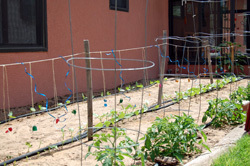Twenty-one Tomato Salute
On Saturday, Jim and I planted twenty-one tomato seeds.�� Our goal is to have twelve plants bearing tomatoes by the end of the summer.�� We���ll be happy with six, especially if five of them are romas, because romas are good both for eating fresh and for cooking.

Tomatoes: Getting Started
Later that day, it occurred to me that once again gardening had provided a very good metaphor for writing.
Tomatoes are to Seeds as Stories are to _______.
If you filled in the blank with ���Ideas,��� you can pat yourself on the back. ����Every writer has more story ideas than they do stories.�� Even non-writers have lots of story ideas.�� ���What if?��� is a very prolific producer of seeds.
There���s a reason that tomatoes produce so many seeds.�� That���s because the likelihood of any one seed germinating is very small.�� Even if the seed germinates, there are a lot of things that can keep the plant from producing mature fruit.
When the plant is small, weather conditions are probably the biggest enemy.�� A newly germinated tomato plant is tiny.�� It has two little leaves and a thread-like stem.�� A heavy rainstorm can bury the baby plant in mud.�� Out here in New Mexico, the burying agent is more likely to be windborne sand.�� End result is the same.�� Death by suffocation.
Even when plants are large enough survive being buried, the challenge isn���t over. ����Cutworm grubs can girdle the stem of a young plant, cutting it off just below the soil line.�� ��A myriad of diseases, carried both in the soil and by insects, can infect your plants.�� Tomato hornworms (also called tomato worms or just ���hornworms,��� for short) love how tomato plants taste.�� I���ve seen a vital vine stripped bare in a few hours, holes drilled indiscriminately in both fruit and the stems of the plant.
Tomato plants are remarkably picky about the temperature range in which they���ll set fruit.�� Where I live, daily temperature shifts of thirty degrees are usual.�� Forty degrees are common.�� That means you can have a day in the eighties, dropping down to forties at night.�� This is very confusing to the plants, who can���t decide whether it���s summer or winter.
Uneven moisture can lead to cracking (sometimes called ���cat-facing���) and blossom-end rot.�� In both cases, with some judicious trimming, the tomato is usually edible, but it isn���t very attractive.
So why bother?�� After all there are lots of tomatoes out there.�� You can buy pretty good ones for as little as ninety-nine cents a pound.�� If you want to spend more, you can buy some really flavorful tomatoes.
I guess the only answer, whether you���re talking about tomatoes or stories, is you do it because you enjoy the process, even when the end result of the process is a deep sigh and a hope that things will work out better next time.�� If you don���t enjoy the process of planting the seed, seeing it sprout, feeding and watering the young plant so that it grows strong, watching the flowers develop, looking for the first blush on the green fruit, there���s no crime in letting someone else grow the tomatoes ��� or write the story.
But if you do enjoy the process, then the experience ��� not just the end result ��� is worth all the effort.�� And the flavor of something you���ve grown yourself is exquisite beyond belief.
P.S.�� I was just reminded that tomatoes once provided the seed of a story for me.�� It���s called ���Between Tomatoes and Snapdragons��� and will be reprinted in my forthcoming short story collection Prime Curiosities.





